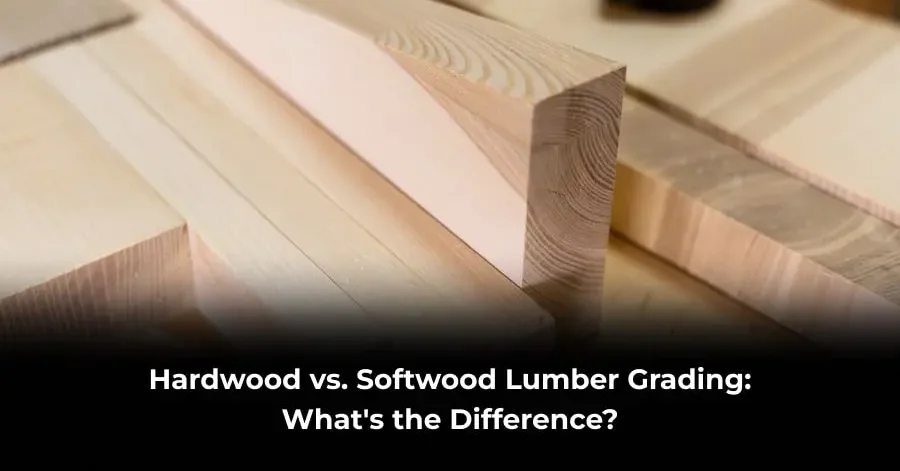Walking into a well-stocked woodworking supplies store can be an overwhelming experience. Towering stacks of lumber, each board with its own unique character and a cryptic stamp or sticker, can leave even seasoned crafters scratching their heads. The secret to navigating this forest of choices lies in understanding the lumber grading system. But here’s the catch: hardwood and softwood are graded by entirely different rulebooks.
Think of it like sports. Grading hardwood is like judging gymnastics—it’s about the beauty, clarity, and potential of an individual piece. Grading softwood is more like judging a soccer team—it’s about structural strength and how the pieces work together. Understanding this distinction is the single most important skill you can bring to your next project, ensuring you get the right material for the job without blowing your budget.
Let’s demystify these systems, so you can walk into any woodworking supplies store with the confidence of a master carpenter.
Part 1: The Philosophy Behind the Grades
Before we dive into the specifics, let’s set the stage. Why are the systems so different? It all comes down to the primary use of the wood.
- Hardwoods (like Oak, Maple, Walnut) typically come from deciduous trees that lose their leaves. They are prized for their beauty, density, and durability. They are most often used for furniture, cabinetry, flooring, and fine woodworking—where appearance is paramount.
- Softwoods (like Pine, Cedar, Spruce) come from coniferous, evergreen trees. They are widely used for framing houses, building decks, and general construction—where structural integrity is the top priority.
This fundamental difference in application is the reason we have two separate lumber grading system approaches.
Part 2: Decoding the Hardwood Lumber Grading System
The National Hardwood Lumber Association (NHLA) sets the standard for hardwood grading in the United States. Their system is based on one primary principle: yield. Yield is the percentage of clear, defect-free wood you can get from a single board. It’s a measure of potential, not perfection.
Hardwood grades are assigned by inspecting the poorer-looking face of the board and calculating how many clear “cuttings” can be made from it. The grades, from highest to lowest, are:
- FAS (First and Second)
This is the cream of the crop, ideal for high-end furniture and large panels.
- Minimum board size: 8″ wide x 12′ long.
- Yield: 83.3% clear face cuttings.
- What to expect: Large, mostly clear sections with minimal defects. When you visit a premium woodworking supplies store, this is the grade they’ll show you for your finest projects.
- Select
Often equivalent to FAS in quality but allows for slightly smaller board sizes. It’s a great balance between quality and cost for many projects. - No. 1 Common
This is the workhorse grade for the everyday woodworker. Don’t let the “Common” name fool you; it’s full of character and value.
- Yield: 66.6% clear face cuttings.
- What to expect: More knots, mineral streaks, and other “defects” that many crafters see as features. Perfect for cabinet parts, tabletops that will be painted, or rustic furniture. A savvy shopper at a woodworking supplies store can find incredible beauty in this grade.
- No. 2 Common
This grade is all about economy and character.
- Yield: 50% clear face cuttings.
- What to expect: Significantly more defects, but also lower cost. Excellent for flooring, pallet-making, or projects where the wood will be heavily processed.
Visualizing the Grade: To truly understand these grades, it’s incredibly helpful to look at wood grade images. A quick online search for “NHLA grading chart” will show you side-by-side comparisons that make the yield percentages instantly understandable. Seeing a wood grade images collection is the fastest way to train your eye.
Part 3: Understanding the Softwood Lumber Grading System
Softwood grading is governed by several rules, but the most common is set by the American Lumber Standard Committee. The focus here is strength and utility. Grades are often stamped directly on the wood at the mill.
Softwood grades fall into three main categories:
- Yard Lumber (The one you’ll see at the home center)
This is what most DIYers encounter. It’s sorted into:
- Select Lumber: Graded for appearance (A, B, C, D). “A Select” is smooth and paintable, while “D Select” has large knots.
- Common Lumber: Graded for utility, not looks (No. 1, No. 2, No. 3). No. 2 Common is the standard for framing a house—it’s strong enough for the job but contains visible knots.
- Structural Lumber
This is the backbone of your home. Grades like “Select Structural,” “No. 1,” and “No. 2” are based on engineering properties like fiber strength and stiffness. The stamp will also include information about wood species, moisture content, and the mill it came from. - Appearance Lumber
This is the softwood you’d use for a beautiful cedar chest or a clear pine bookshelf. It’s graded similarly to select yard lumber but is chosen for its visual appeal.
When you’re at the woodworking supplies store picking out pine for a shelf, you’re navigating the Yard Lumber lumber grading system. You’re choosing between the clean look of a “C Select” and the rugged, knotty character of a “No. 2 Common.”
Part 4: Side-by-Side: Your Quick-Reference Cheat Sheet
| Feature | Hardwood Grading | Softwood Grading |
| Governing Body | National Hardwood Lumber Assoc. (NHLA) | American Lumber Standard Committee |
| Primary Focus | Appearance & Yield | Strength & Utility |
| Grading Method | Visual inspection for clear cuttings | Mechanical stress-testing & visual inspection |
| Common Grades | FAS, Select, No. 1 Common, No. 2 Common | Select (A-D), Common (No. 1, 2, 3), Structural |
| Ideal For | Furniture, Cabinetry, Flooring | Framing, Construction, Decks, Some Furniture |
Part 5: AEW Woods: Your Partner in Quality Lumber
Now that you’re an expert on the lumber grading system, you need a source you can trust. This is where AEW Woods comes in. For years, AEW Woods has been a cornerstone for craftsmen and builders, providing top-tier materials and expert advice.
At AEW Woods, we understand that a board of wood is more than just a material; it’s the beginning of a project filled with passion. That’s why we don’t just sell lumber—we curate it. Our team helps you navigate the complexities of grades, ensuring you find the perfect balance of beauty, strength, and budget for your specific needs. Whether you’re a professional seeking flawless FAS hardwoods or a DIYer looking for character-rich Common grades, AEW Woods is your definitive woodworking supplies store. We pride ourselves on an extensive inventory, from domestic staples to exotic finds, all clearly graded so you know exactly what you’re getting.
Conclusion
Navigating the world of lumber grading doesn’t have to be a daunting task. By understanding that hardwoods are graded on beauty and yield, while softwoods are graded on strength and utility, you can make informed, confident decisions. The lumber grading system is not a barrier but a tool—a language that, when learned, unlocks the full potential of every board you buy.
The next time you step into your favorite woodworking supplies store, whether it’s a local gem or a trusted partner like AEW Woods, take a moment. Look at the stamps, examine the grain, and appreciate the character. You’re no longer just buying wood; you’re selecting the perfect ingredient for your next creation. Armed with this knowledge, you can ensure that your project is built on a foundation of quality, understanding, and the right wood for the job.
Frequently Asked Questions (FAQs)
- Can I use construction-grade softwood (like a 2×4) for making furniture?
Absolutely! “Knotty pine” furniture is a classic look. Just be aware that the wood is often wetter (higher moisture content) and may warp as it dries. It also dents more easily than hardwood. For a rustic, painted piece, it’s a fantastic and economical choice. - Why is a lower-grade hardwood sometimes more expensive than a higher-grade softwood?
The cost is driven by the tree species itself. A slow-growing oak tree (a hardwood) is inherently denser and more durable than a fast-growing pine (a softwood). The scarcity and inherent properties of the wood species have a much larger impact on price than the grade within that species. - Where can I find reliable “wood grade images” to help me learn?
The best resources are the official websites of the grading agencies, like the NHLA. Many reputable lumber suppliers and woodworking supplies store blogs also have excellent visual guides and charts to help with identification. - Is one system better than the other?
No, they are just designed for different purposes. The hardwood system is better for predicting aesthetic output, while the softwood system is better for guaranteeing structural performance. Using the right lumber grading system for your project is key. - How does moisture content affect the grade?
Moisture content is critical, especially for softwood structural lumber where it’s part of the grade stamp (e.g., S-DRY for 19% or less). For hardwoods used in fine furniture, the wood must be properly kiln-dried to 6-8% moisture content to prevent future warping and cracking. A reputable dealer like AEW Woods ensures all lumber is properly dried for its intended use.






